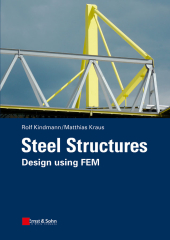 Neuerscheinungen 2011Stand: 2020-01-07 |
Schnellsuche
ISBN/Stichwort/Autor
|
Herderstraße 10
10625 Berlin
Tel.: 030 315 714 16
Fax 030 315 714 14
info@buchspektrum.de |

Rolf Kindmann, Matthias Kraus
(Beteiligte)
Steel Structures
Design using FEM
1. Aufl. 2011. XII, 540 S. 365 SW-Abb., 90 Tabellen. 240 mm
Verlag/Jahr: ERNST & SOHN 2011
ISBN: 3-433-02978-4 (3433029784)
Neue ISBN: 978-3-433-02978-7 (9783433029787)
Preis und Lieferzeit: Bitte klicken
Die Finite-Elemente-Methode (FEM) bildet heute in der Praxis der Bauingenieure ein Standardverfahren zur Berechnung von Tragwerken. Nach einer Einführung in die Methodik konzentriert sich das Buch auf die Ermittlung von Schnittgrößen, Verformungen, Verzweigungslasten und Eigenformen für Stahlkonstruktionen. Neben linearen Berechnungen für Tragwerke bilden die Stabilitätsfälle Biegeknicken, Biegedrillknicken und Plattenbeulen mit der Ermittlung von Verzweigungslasten und Berechnungen nach Theorie II. Ordnung wichtige Schwerpunkte. Hinzu kommt die Untersuchung von Querschnitten, für die Berechnungen mit der FEM zukünftig stark an Bedeutung gewinnen werden. Für praktisch tätige Ingenieure und Studierende gleichermaßen werden alle notwendigen Berechnungen für die Bemessung von Tragwerken anschaulich dargestellt.
This book presents the design of steel structures using finite element methods (FEM) according to the current state of the art in Germany and the rest of Europe. After a short introduction on the basics of the design, this book illustrates the FEM with a focus on internal forces, displacements, critical loads and modal shapes. Next to finite element procedures for linear calculations considering the stress states of normal force, biaxial bending and warping torsion, non-linear calculations and the stability cases of flexural buckling, lateral torsional buckling and plate buckling are concentrated on significantly. In this context, design procedures for stability according to the standard Eurocode 3 is introduced and discussed. In addition, important fundamental issues are covered, such as the determination of cross-section properties as well as the elastic and plastic cross-section resistance. Complementary, finite element procedures for cross sections are dealt with, which will have an increasing importance in future.
This book has evolved within the teaching activities of the authors in the lecture Computer-oriented Design of Steel Structures on the Master?s Program Computational Engineering at the University of Bochum. It covers the total variety of demands needed to be discussed for the safe, economic and modern design of steel structures.
Introduction and General Overview
Cross Section Properties
Principles of the FEM
FEM for Linear Calculations of Lattice Structures
FEM for Nonlinear Calculations of Lattice Structures
Solution of Equation Systems and Eigenvalue Problems
Stresses According to the Theory of Elasticity
Plastic Cross Section Bearing Capacity
Verification of Beams: Second Order Theory and Stability
FEM for Plane Load-Bearing Structures
FEM for Beam Cross Sections


